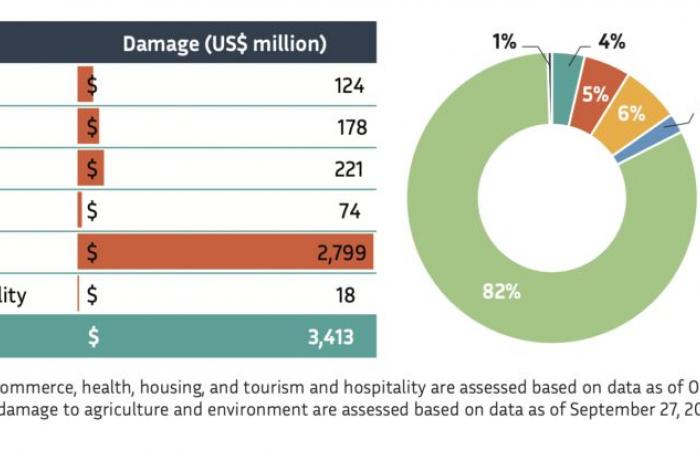– Advertisement –
Since the start of the conflict in Lebanon, human and material costs have been accumulating, exerting unprecedented pressure on the country's economy and infrastructure. According to the recent World Bank report entitled Lebanon Interim Damage and Loss Assessment (DaLA)the conflict caused material damage estimated at $3.4 billion and economic losses reaching $5.1 billion.
1. Overview of damage and losses
The conflict has caused significant damage to infrastructure and businesses across Lebanon. The DaLA report distinguishes two types of economic impacts: material damage, representing the replacement costs of destroyed infrastructure and property, estimated at $3.4 billion, and economic losses, corresponding to loss of income and production. due to interruptions in economic activities, totaling $5.1 billion over a 12-month period. These costs are distributed among seven key sectors: agriculture, trade, environment, health, housing, tourism, and education. The sectoral distribution of damage and economic losses provides an overview of priorities for reconstruction and humanitarian assistance. In addition, the report anticipates a worsening of these figures if the conflict continues, since several sectors not included in this assessment, such as electricity and transport, continue to suffer direct and indirect impacts.
| Type of damage | Montant total (USD) |
|---|---|
| Material damage | 3.4 billion |
| Economic losses | 5.1 billion |
| Total (damage + losses) | 8.5 billion |
2. Details of sectoral impacts
Agriculture
The Lebanese agricultural sector, already weakened by the 2019 economic crisis, suffered damage estimated at $124 million and losses of $1.1 billion. The areas of Bekaa, Nabatiyeh and the South, the main agricultural regions, particularly suffered from the destruction of crops and the loss of livestock. Before the conflict, these regions produced up to 80% of the country's agricultural output, contributing to local and international markets, with essential crops such as citrus fruits, bananas and olives. The destruction of agricultural infrastructure, particularly irrigation systems and processing equipment, also contributed to these losses, in addition to damaged crops. The impact of the conflict on this sector could be felt in the long term, affecting not only farmers' incomes, but also the country's food security. Annual losses, estimated at $601 million for crops and $533 million for livestock, reveal the fragility of a vital sector for the local economy and the population. The agricultural sector could require up to three years of recovery, even if conflicts end.
| Sector | Dommages (USD) | Annual losses (USD) |
|---|---|---|
| Agriculture | 124 millions | 1.1 billion |
Commerce
Trade, which accounted for around 33% of Lebanese GDP before the conflict, suffered damages to the tune of $178 million, while annual losses are estimated at $1.7 billion. The massive displacement of workers and business owners in the Tire, Saida and Nabatiyeh areas has crippled the sector, significantly reducing economic activity. Around 11% of commercial establishments in affected areas are partially or completely destroyed. The temporary or permanent closure of many businesses has reduced access to essential goods, forcing consumers to limit their spending on basic necessities. In less affected areas, disruptions to supply chains have also led to stock shortages, affecting the sector's ability to recover. Changes in consumption habits, with a sharp reduction in non-essential goods, could also cause a lasting decline in income in this sector.
| Sector | Dommages (USD) | Annual losses (USD) |
|---|---|---|
| Commerce | 178 millions | 1.7 billion |
Environment
The conflict caused environmental damage estimated at $221 million and annual losses of $214 million. Forests, meadows and riparian ecosystems, essential to ecological balance and quality of life, have been devastated in the governorates of the South, Nabatiyeh and Bekaa. The degradation of these natural resources leads to additional costs for the restoration of biodiversity and ecosystem services. About 13% of forests, 16% of grasslands and 17% of riparian ecosystems are affected. Environmental losses include reduced revenues from ecosystem services, such as water purification and soil fertility, estimated at $198 million per year. Contamination of soil and water sources with toxic materials, particularly in areas near front lines, could require decades to return to a stable state. In the long term, this would compromise local living conditions, increase the risk of desertification and increase vulnerability to natural disasters.
| Sector | Dommages (USD) | Annual losses (USD) |
|---|---|---|
| Environment | 221 millions | 214 millions |
Health
The health sector, mainly made up of private institutions, suffered damages estimated at $74 million, and economic losses reached $338 million. The conflict has seriously affected health infrastructure, particularly in the South and Nabatiyeh, where 66% of hospitals and 36% of primary health centers are damaged or out of service. With 31 hospitals and 26 primary health centers damaged, the health crisis has become one of the main challenges for the country. The lack of medical personnel and the destruction of health infrastructure contribute to an increase in mortality and illness, accentuating inequalities in care. Additionally, loss of revenue from non-operational or partially operational health facilities contributes to increased pressure on health financing, further limiting access to care for the most vulnerable.
| Sector | Dommages (USD) | Annual losses (USD) |
|---|---|---|
| Health | 74 millions | 338 millions |
Accommodation
The housing sector is the most affected, with damages estimated at $2.8 billion and economic losses of $389 million. Nearly 100,000 housing units, or around 8% of the housing stock in the regions concerned, were damaged. The governorates of the South, Nabatiyeh and Bekaa concentrate 81% of the damage. The scale of the destruction suggests a long-term housing crisis, with profound repercussions on the living conditions of thousands of displaced families. This destruction of the real estate stock also causes a significant drop in tax revenues from properties and a slowdown in the real estate market in the affected areas. Furthermore, high reconstruction costs could dissuade future investments in the sector, accentuating housing inequalities.
| Sector | Dommages (USD) | Annual losses (USD) |
|---|---|---|
| Accommodation | 2.8 billion | 389 millions |
Tourism and hospitality
Tourism, a traditional pillar of the Lebanese economy, has been strongly impacted. Damage is estimated at $18 million, while annual losses amount to $1.1 billion, caused by a drastic drop in tourist arrivals and hotel occupancy rates, which fall to less than 10 % in summer 2024. The decrease in tourist arrivals has impacted several sub-sectors such as accommodation, restaurants and retail, leaving a lasting imprint on the hospitality sector and the revenues derived from it. Evacuations and travel restrictions recommended by many countries have also accentuated this crisis. In the long term, the revival of tourism will depend on the political and security stability of the country, as well as the ability to regain the confidence of foreign visitors.
| Sector | Dommages (USD) | Annual losses (USD) |
|---|---|---|
| Tourism | 18 millions | 1.1 billion |
3. Macroeconomic analysis and overall impact on GDP
According to the World Bank report, the conflict is expected to reduce Lebanese GDP growth by 6.6% for the year 2024. This adds to a contraction of more than 34% in real GDP since 2019, an equivalent economic loss at 15 years of growth. In 2023, private consumption represented 134% of GDP; Current economic disruptions have significantly slowed this key component of growth. The conflict has also affected foreign trade, particularly in the services sector, with a decline in service exports due to the collapse of the tourism sector. The fall in private consumption, due to population displacement and loss of income, is exacerbating the economic slowdown, reducing the prospects for recovery in a context of prolonged crisis. The collapse in consumption, caused by job losses and rising prices of essential goods, increases the overall impact on growth, heightening the risk of recession.
| Year | Projected GDP growth in % |
|---|---|
| 2023 | 0.9 (no conflict) |
| 2024 | -5,7 |
4. Humanitarian crisis and population displacement
The conflict has caused massive population displacement, with more than 875,000 people internally displaced. This situation has worsened the humanitarian crisis in Lebanon, increasing pressure on public services, particularly in the areas of health, education, and water and electricity supplies. Approximately 166,000 people lost their jobs, representing an estimated annual loss of $168 million in income. Host regions, such as Beirut, face increased demand for basic services, posing an additional burden on already strained local authorities. Women, children, the elderly and people with disabilities are the most vulnerable to this massive displacement. Growing demand for emergency housing and health services for displaced people is putting strain on local infrastructure, worsening social tensions and logistical challenges.
5. Long-term prospects and reconstruction needs
Faced with these cumulative losses, Lebanon faces major challenges in considering sustainable reconstruction. The World Bank plans to launch a Rapid Needs Assessment (RDNA) once the situation stabilizes. This assessment will be essential to determine funding priorities for infrastructure reconstruction and to revive economic activities. The World Bank is currently working to activate emergency response plans, aimed at redirecting existing resources to meet the immediate needs of affected populations. However, the needs for complete and sustainable reconstruction remain high, and will require international assistance and coordination of public and private actors.
The scale of damage and losses caused by the conflict in Lebanon represents a significant drag on the Lebanese economy and the prospects for recovery. The destruction of infrastructure, human and economic losses, and increasing humanitarian and social needs call for a rapid response and sustained commitment to reconstruction. Lebanon will also need to rely on innovative and sustainable solutions to strengthen its resilience to future crises. This report highlights the need for the country to prepare for a long-term reconstruction phase, supported by international funding and strengthening the resilience capacities of local communities.
P5063801c62fbe0c21beff1d0a436d07e02
– Advertisement –






